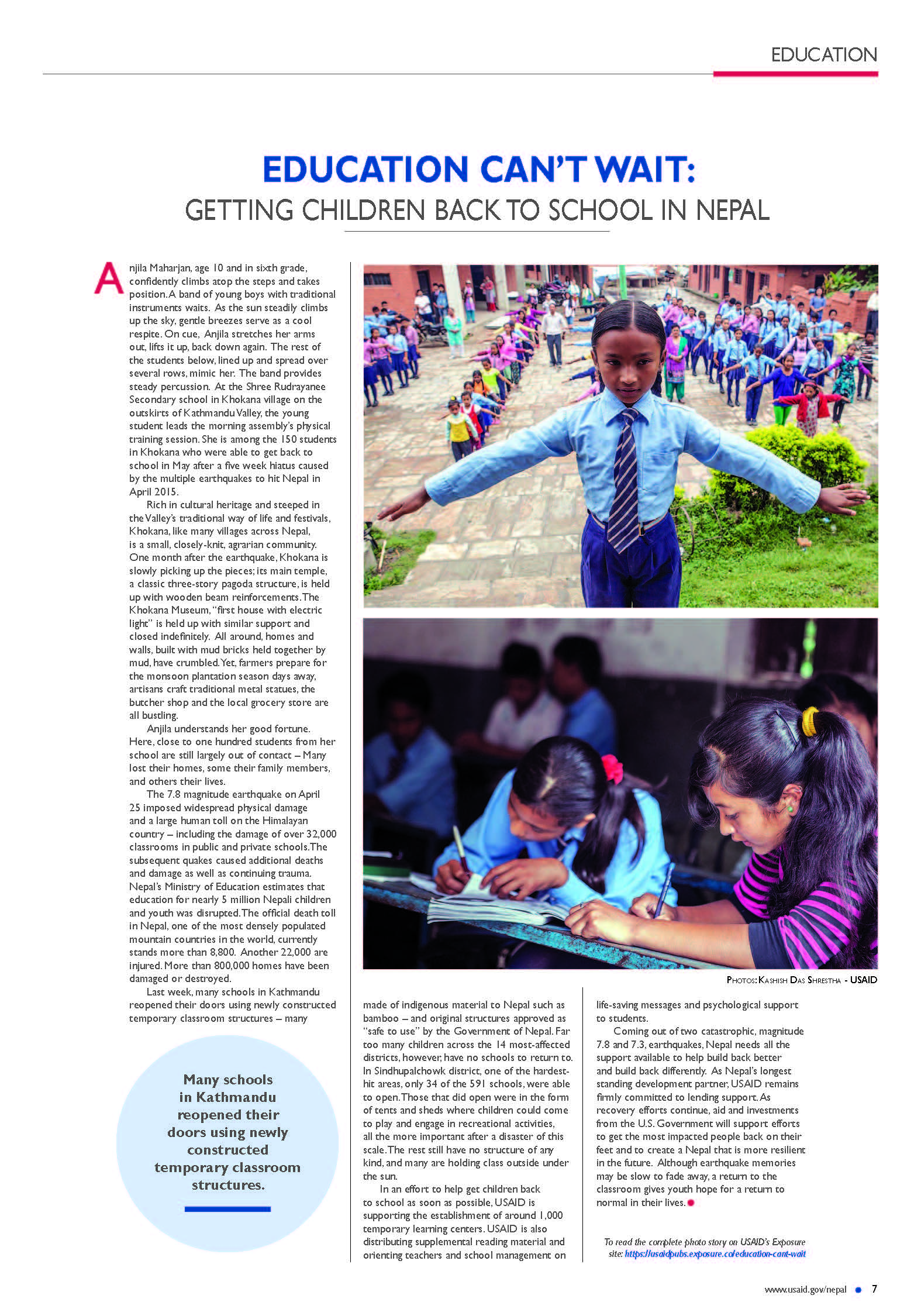Getting Children Back to School in Nepal
Nepal Quarterly Newsletter, April-June 2015
Anjila Maharjan, age 10 and in sixth grade, confidently climbs atop the steps and takes position. A band of young boys with traditional instruments waits. As the sun steadily climbs up the sky, gentle breezes serve as a cool respite. On cue, Anjila stretches her arms out, lifts it up, back down again. The rest of the students below, lined up and spread over several rows, mimic her. The band provides steady percussion. At the Shree Rudrayanee Secondary school in Khokana village on the outskirts of Kathmandu Valley, the young student leads the morning assembly’s physical training session. She is among the 150 students in Khokana who were able to get back to school in May after a five week hiatus caused by the multiple earthquakes to hit Nepal in April 2015.
Rich in cultural heritage and steeped in the Valley’s traditional way of life and festivals, Khokana, like many villages across Nepal, is a small, closely-knit, agrarian community. One month after the earthquake, Khokana is slowly picking up the pieces; its main temple, a classic three-story pagoda structure, is held up with wooden beam reinforcements. The Khokana Museum, “first house with electric light” is held up with similar support and closed indefinitely. All around, homes and walls, built with mud bricks held together by mud, have crumbled. Yet, farmers prepare for the monsoon plantation season days away, artisans craft traditional metal statues, the butcher shop and the local grocery store are all bustling.
Anjila understands her good fortune. Here, close to one hundred students from her school are still largely out of contact – Many lost their homes, some their family members, and others their lives.
The 7.8 magnitude earthquake on April 25 imposed widespread physical damage and a large human toll on the Himalayan country – including the damage of over 32,000 classrooms in public and private schools.The subsequent quakes caused additional deaths and damage as well as continuing trauma. Nepal’s Ministry of Education estimates that education for nearly 5 million Nepali children and youth was disrupted. The official death toll in Nepal, one of the most densely populated mountain countries in the world, currently stands more than 8,800. Another 22,000 are injured. More than 800,000 homes have been damaged or destroyed.
Last week, many schools in Kathmandu reopened their doors using newly constructed temporary classroom structures – many made of indigenous material to Nepal such as bamboo – and original structures approved as “safe to use” by the Government of Nepal. Far too many children across the 14 most-affected districts, however, have no schools to return to. In Sindhupalchowk district, one of the hardest-hit areas, only 34 of the 591 schools, were able to open. Those that did open were in the form of tents and sheds where children could come to play and engage in recreational activities, all the more important after a disaster of this scale. The rest still have no structure of any kind, and many are holding class outside under the sun.
In an effort to help get children back to school as soon as possible, USAID is supporting the establishment of around 1,000 temporary learning centers. USAID is also distributing supplemental reading material and orienting teachers and school management on life-saving messages and psychological support to students.
Coming out of two catastrophic, magnitude 7.8 and 7.3, earthquakes, Nepal needs all the support available to help build back better and build back differently. As Nepal’s longest standing development partner, USAID remains firmly committed to lending support. As recovery efforts continue, aid and investments from the U.S. Government will support efforts to get the most impacted people back on their feet and to create a Nepal that is more resilient in the future. Although earthquake memories may be slow to fade away, a return to the classroom gives youth hope for a return to normal in their lives.
To read the complete photo story on USAID’s Exposure site: https://usaidpubs.exposure.co/education-cant-wait








Comment
Make a general inquiry or suggest an improvement.